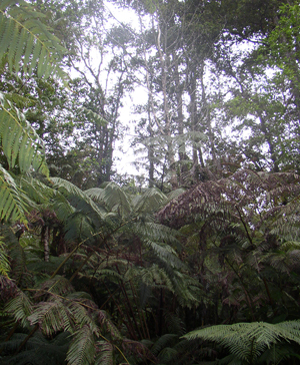Exotic Timber Plantations Found To Use More Than Twice the Water of Native Forests
Vegetation in an area may determine its usable water supply, ecologists find
Ecologists have discovered that timber plantations in Hawaii use more than twice the amount of water to grow as native forests use. Especially for island ecosystems, these findings suggest that land management decisions can place ecosystems – and the people who depend on them – at high risk for water shortages.
“Scientists used to think that forests in same environments use water in the same way,” says Lawren Sack of The University of California at Los Angeles, who coauthored the study with graduate student Aurora Kagawa in the September issue of the ESA journal Ecological Applications. “Our work shows that this is not the case. We need to know the water budget of our landscape, from gardens to forests to parks, because water is expensive.”
Although forests like these Hawaiian timber plantations can be valuable for their contributions to human society, such as fiber, fuel and carbon sequestration, they are dominated by non-native vegetation.
Kagawa, Sack and their colleagues compared the water use of trees in native forests, composed mostly of native ohia trees, with water use in timber plantations containing exotic eucalyptus and tropical ash. The team inserted heated and unheated probes into the trees’ trunks and monitored the temperature differences between the two as sap flowed past them. This technique allowed them to determine the rate of sap flow through the tree. A faster flow rate means that the tree is using more water.
“The way plants grow determines how fast they can take up water,” says Sack. “Plants open their leaf pores, called stomata, to take in carbon dioxide. But when these pores are open, the plants also lose water. Like a wet towel on a clothesline, the insides of the leaf can dry pretty quickly.” Since fast-growing exotic plants typically have more open leaf pores than native, slow-growing trees, Sack says, they lose more water in less time.
The researchers found that individual eucalyptus and tropical ash used three and nine times more water, respectively, than individual ohia trees. Since each of these forests is dominated by these three species, the team was able to scale up their results to predict how much water a whole section of forest uses. Even when including other native plants that use water quickly, such as tree ferns, the tropical ash forests still used water at a rate of 1,800 grams of water per square meter per day, more than 2.5 times that of the other forests. The researchers found, however, that the non-native eucalyptus plantation used similar amounts of water as native forest. This is because water use depends on the specific tree species, stand organization and age, and location and climate, says Sack.
Hawaii’s non-native tree plantations were originally intended for timber production and to conserve the islands’ top soil. In the early part of the 20th century, ranches and plantations producing sugar cane and pineapple covered much of Hawaii’s agricultural areas. But years of these practices led to increased soil erosion, and fast-growing non-native trees were planted to hold the soil in place and to preserve water by preventing runoff. At the time, however, the importance of biodiversity and the dangers of exotic species weren’t as clear as they are today.
Especially with climate change rapidly changing many ecosystems, Sack says, it’s vital that land management plans recognize and integrate the fact that water use by plants can affect the clean water supply.
“When making decisions to restore a native forest or preserve or establish a plantation, we need to do a more detailed valuation that includes the cost of water they’re using,” he says. “There are a lot of reforestation projects underway to take up carbon dioxide from the atmosphere, where people are prioritizing fast-growing trees. But we shouldn’t let alien plants sweep over native forests. Our findings make a clear case that we need to know how much water landscapes are using and conserving.”


Click on picture for a high resolution image
The photos from that press release are by Aurora Kagawa.